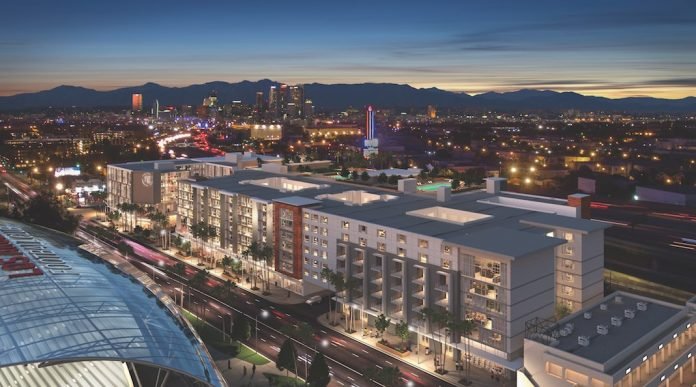Since Scott Gale founded Ventus Group in 2006, he has acquired and/or consulted on a broad array of properties, including residential, mixed-use, and commercial projects throughout the Western United States. But, since 2014, the Ventus president has been completely devoted to just one: the Fig, a 4.4-acre, multi-use project at Figureoa Street near the University of Southern California. While speaking to LODGING, Gale discussed the trend toward mixed-use development in general, as well as this massive undertaking, which will include hotel, residential, and retail spaces.
Gale says there are good reasons to mix assets, even those that take guests off hotel premises to other restaurants, shops, and sites. “All area attractions, including retail and restaurants outside the property, serve as an amenity that enhances its value. Guests enjoy the convenience of being close to campus while being able to gather with friends, family, and colleagues outside of a hotel room or restaurant.”

Gale says that luck played a major part in his group’s purchase of the Fig, which, it turned out, was placed near attractions that had not yet been announced. “I’d like to say we were smart, but we were actually very lucky with timing,” he explains. “Immediately after we started working on the project and assembling the land, local officials started announcing the new stadiums, then the museums, and then the Olympics.”
As a result he says, “Apart from our own internal demand drivers, we have a 160-acre park across the street, two stadiums, and the Lucas Museum now being built—so, whether it’s for business or pleasure, there are reasons to stay on and explore.”
The Fig, says Gale, will technically be made up of four structures: a hotel, student housing, conventional multifamily housing, and a parking structure that serves them. The first three structures will also have ground-floor retail. Gale goes on to describe that the hotel will be a mixture of extended-stay (138) and select-service (160) guestrooms. “The extended-stay segment of the property is geared toward traveling faculty and educational seminars for executive students in for weekends,” he notes.
Gale adds that the trend away from “big box” hotels in favor of mixed assets sees support from both financial backers and community planners as well as travelers, because the combination of housing, restaurants, and retail provides a more robust service to the community. “In the past, city officials resisted these types of projects. They objected to their complexity because each component would need to be analyzed in different ways. But as city planning has become more sophisticated, and many of these projects have proved to be outstanding, communities have become more receptive.”
Although Gale does not predict a downturn any time soon, he knows the situation may change at any time. “The big concern is having the financing turn against you. A project may still make sense, but when the banks think there are clouds on the horizon and tighten up financing, an otherwise good project might lie dormant until its cash flow prospects improve.” Multi-use or mixed-use projects, he says, offer some measure of protection. “They provide a more diverse set of demand drivers, which means you can weather a more diverse set of storms.”
Gale admits that while mixed-use properties offer financiers some protection, they can be more complicated when it comes to securing a lender. “They need to analyze the financing for each building individually. This is because they look for different ratios and different ways of evaluating the market. For instance, a hotel financing group that doesn’t particularly like one component may not offer the most competitive overall financing because it will be handicapped based on their concerns about that product type.”
Nevertheless, Gale says, the capital world has developed not just an acceptance of, but an appetite for mixed-used projects, which he says are regarded as “a proven product at this point.” However, he warns. “One overarching thought—which is true of all urban development—you have to be careful of where your competition can come in. It’s best to aggressively seek a site that is generally insulated and protected from incoming competition.”












The headline and the story do not match, unless one property and one developer can be indicative of a trend. And, regardless of the scope of Mr. Gale’s property, it is not necessarily the portent of a trend.
In my hometown of Chicago, the Four Seasons Hotel, the Ritz-Carlton Hotel and the Park Hyatt Hotel are in developments that include condominiums, high-end retail and offices (the Park Hyatt does not have offices). Three properties within a few blocks of one another in one city may be a trend. One property is not. By the way, the youngest of those propeties, the Park Tower, is about 20 years old, so the “trend” started many, many years ago.
Do better, LODGING, do better.